| Columns Retired Columns & Blogs |
With a minimum impedance load of 0.33 Ohms, we need an amp like the Relentless to drive them :-) .......
Given the 1 ohm value for the impedance indicated by the specification, I first looked at the impedance characteristic to see whether it was really as difficult as indicated. On the normal chart my bottom line is 1 ohm; on the first run, the pen fell way below the line at 2kHz, impacting the limit stop. I then up-ranged by 10dB to set the base line at 0.32 ohms, and the WATT loading just kissed the 0.33 ohm level at 2kHz (fig.1). In some disbelief I felt the need to recalibrate the system and go for a manual static measurement; however, the same result was obtained, to within 2% accuracy. So there it is, the WATT presents an inexcusably difficult load over a very narrow frequency notch.
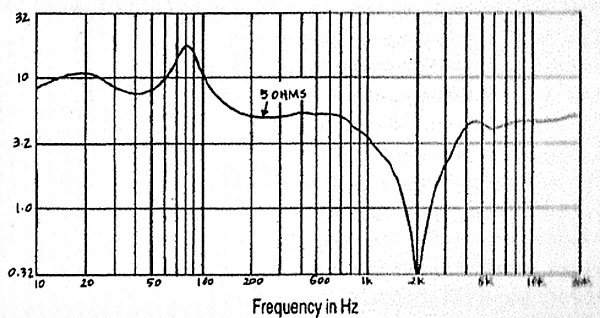
In fact, it was so low that many cable sets will provide some partial protection, typically raising the impedance to a total of 0.5 ohm. For some reason, Wilson has chosen to suck out electrical energy in the crossover by a parallel tuned circuit—perhaps to correct the phase/amplitude response at the crossover frequency between the two drivers. Such a circuit, if unbuffered by a series crossover element, will go to nearly zero resistance at resonance—the residual value measured is the product of the speaker's internal wiring, the equivalent series resistance of the resonant capacitor, plus the winding resistance of the corresponding resonant inductor. Such a narrow notch implies a strongly reactive phase angle for the loading in the 2kHz region, almost purely inductive on one slope and capacitive on the other.
Taken as a worst case, let us assume that the speaker is driven at a 100W (20dBW, 8 ohms) level for peak loudness. A peak current of 10A is drawn by the main 4 ohm loading at one frequency. If two frequencies peak simultaneously, 20A is necessary, this demand becoming increasingly unlikely statistically with an increase in the number of simultaneous peak-level frequencies. Now consider a steady violin or piccolo tone at 2kHz momentarily at full level, and assume we are using a closely positioned monoblock power amplifier with short low-resistance speaker wiring. The peak current will now try to hit 120A—in all probability, the amp will fail to deliver. What is the outcome? Momentary current clipping will occur, only when and if a high-level signal sits precisely on 2kHz.
Music is a dynamic phenomenon—notes run up and down the scale and very few hold any single pitch for any length of time. We have a statistical phenomenon where the amplifier is likely to clip very occasionally, almost unpredictably in the upper midrange. The subjective effect is hard to predict, and will largely depend on the amplifier's speed of recovery from current overload. If rapid, the clipping may pass virtually unnoticed, but if electrical protection is fitted, it may trigger those circuits. If the overload recovery is poor, then the amplifier sound will be degraded in many areas, including those of tonality and focus. Objectively, the effect of such narrow-band clipping is to add occasional "splashes" of rich odd-order harmonics to upper-mid notes, extending up into the treble over at least two octaves. Dynamics can be affected, since transients in the 2kHz region will sound "faster" and more exciting. Subjective "expansion" effects may be created by the added modulation in the treble range. Since most recording systems are to some degree compressive in the upper register, this might be falsely interpreted as a performance enhancement on the part of the loudspeaker.
Given this impedance result, I can only reiterate my opinion that only the largest of amplifiers with a really healthy output will give consistent results with the WATT.
One factor serves to mitigate the wicked impedance, however. The sensitivity was higher than spec at an effective 91dBA for a nominal 8 ohm WATT. Thus high-power inputs are not needed to give respectable in-room sound levels. For example, a modest 400Wpc peak from a robust 100-200Wpc power amp will provide a worthwhile sound level of 102dBA for a stereo pair in an 80m3 room. The worst-case peak current will then be about 70A, just within reach of amplifiers such as the bigger Krells.
While on the subject of impedance, the curve offers further confirmation. In the main range, it lay at 5 ohms—no problem—while the low-frequency area told us about the loading (with the DF 100-400 port). Box resonance lay at a high 80Hz, while the port was fairly weakly tuned at 40Hz in quasi-Butterworth alignment, deliberately overdamped to avoid any chance of transient overhang or boom.
Frequency responses were taken in free space (no Beard) on the forward axis at the recommended angle (fig.2), also at 5° above (fig.3), and for interest's sake, on an axis perpendicular to the angled baffle (fig.4), the latter the axis available to the listener when the speaker is placed directly on the floor. Interestingly with our test amplifier and test level, 1W, plus low-resistance cable (Siltech pure silver), no trace of an acoustic response dip was evident at 2kHz. What was evident was the characteristic rising response of an unequalized bass-mid driver, the output clearly designed for a 2Pi loading reinforcement rather than the near-4Pi test position. The addition of the Beard did not produce more than the average of 1dB's worth of change in the 150–400Hz band, though subjectively assessed it seemed to be worth a little more than this.
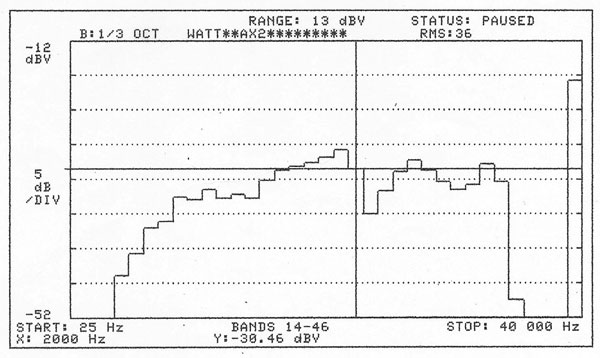


Examining fig.2, the free-field reference line and sensitivity level were defined by the flat midbass level at the "dB/DIN" label. The midband rose to a level 4–5dB higher than this. The treble was more or less to match, with noticeable amplitude lumpiness and signs of a subdued peak in the extreme treble. A 1/3-octave-wide frequency suckout, 6dB deep, occurred at 2.5kHz. At 5° above the recommended axis (fig.3), the 2.5kHz dip increases to 10dB, and the treble is altered, showing different bumps and more emphasis in the high treble. (This was not unexpected, as the microphone was then closer to the tweeter.) Finally, we reach the geometric "normal" axis in fig.4. There the presence dip was almost corrected, but the mid-treble balance was awry.
Based on the reference level at 100–300Hz, the sensitivity was no more than 88dB, but the mid and treble boost placed the subjective loudness at the 91dB level. For this reason, the true sensitivity figure is a matter of interpretation.
The 1/3-octave curve in fig.4 was subjected to narrow-band analysis, the result being shown in fig.5 which has a logarithmic 200Hz–20.2kHz horizontal scale. A significant energy peak can be seen at 5kHz, above which the treble clears up, until it peaks up by 8–9dB around 19kHz. As I am in my late thirties, I would find this peak almost inaudible, except at high sound levels, and only when listening directly on this axis (normal to the front panel). However, I cannot vouch for younger listeners, say 25 and under, who in my experience have proven to be surprisingly sensitive to 19kHz pilot tones in the output of FM tuners measured at 30dB below normal modulation. It is unfortunate that this tweeter peak lies on, or very close to, the multiplex pilot-tone frequency. Fig.6 illustrates the narrow band analysis on the recommended axis, clearly showing two response dips.
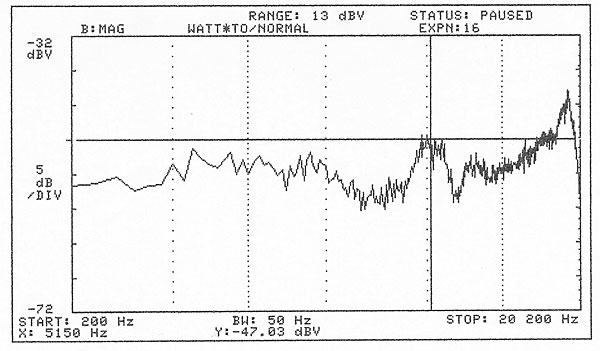
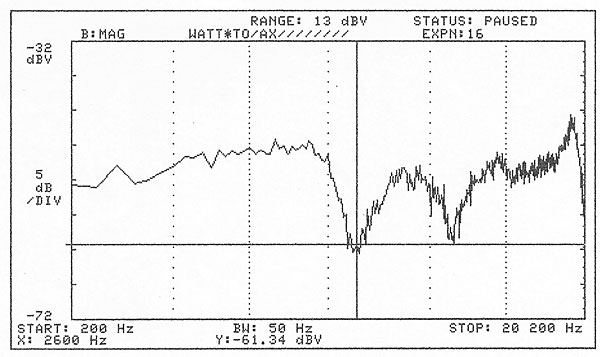
Considering these graphs (figs.2 through 6), I am led to the conclusion that the WATT has a minimal, or at best low-rolloff rate, 6dB/octave crossover, with considerable overlap between the acoustic output of the drivers. Such an overlap will produce the varying responses shown with vertical axis variations, these due to constructive and destructive interference.
Fig.7 is my overlay for the acoustic output in the forward sector, showing the recommended axis, plus the 15° vertical and the 30° and 45° lateral off-axis results. An ideal speaker should show an evenly matched set of traces moderately displaced from the central axial curve. The overall trend to a prominent upper mid was clearly visible, while the 2.5kHz dip was also a constant feature. The precise shape of the treble response was rather axis-dependent, making the speaker sensitive to height, specifically the vertical angle made with respect to the listener's head. Fig.7 would not be classed as an even set of well-integrated responses.
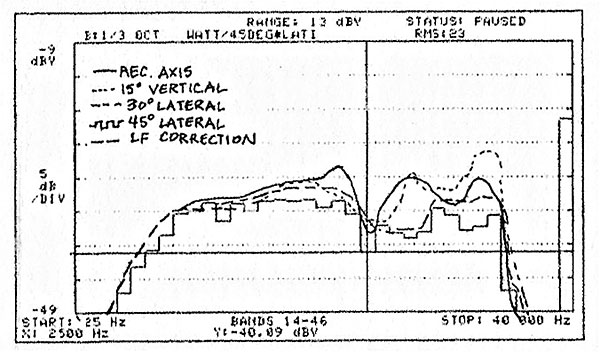
This graph also includes a nearfield-corrected supplement to the low-frequency response which defines the bass rolloff. The specified -6dB bass rolloff depends on the chosen sensitivity—if to the reference 88dB, then it is 60Hz, and if to the subjective 91dBA, then it is only 80Hz. As the room-averaged response will show, the WATT does have bass extension to lower frequencies, but not in a form which has much effect on the listener.
Looking at the computer-averaged, 64-measurement response relating to the sound perceived over the listening position (fig.8), we find much of interest. Note how the individual bumps and dips in the treble have smoothed out, proving that the variations were a driver-interference effect. The 2.5kHz dip (marked by the cursor) has not been fully filled in. The little peak at high frequencies remains; the response should really be rolling off smoothly at this point. However, the dominant feature was the relative output of the bass and midrange and how it balanced in the room acoustic. It all looked very promising up to a few 100Hz, and the efficacy of Wilson's "no-boom" low-frequency tuning was confirmed.

However, above 300Hz, the midrange can be seen to rise in a controlled slope, reaching +6dB by 1.6kHz—the kind of spectral imbalance which cannot be subjectively or objectively ignored (footnote 1). The 2.5kHz dip actually helped to redress the balance a little, while the treble was held back somewhat to avoid excessive brightness. In my opinion, this balance may give correct results when supported by the large, 2Pi-baffle effect of a studio mixing console, but is inappropriate to free-field domestic use. I also feel that the documentary evidence outlined above strongly supports the results obtained during the auditioning.—Martin Colloms

With a minimum impedance load of 0.33 Ohms, we need an amp like the Relentless to drive them :-) .......

... could have afforded the B&W 801 Matrix Series 2, the Infinity IRS Delta, the KEF R107, the Magnapan Tympani IVa or the Martin-Logan Monolith.
https://www.stereophile.com/floorloudspeakers/506/index.html
http://www.infinity-classics.de/models/IRS-series+Beta+Gamma-Delta-Sigma-Epsilon-1988-95-98/IRS-Gamma-Delta/body_irs_gamma.html
https://www.stereophile.com/floorloudspeakers/550/index.html
https://www.stereophile.com/content/magnepan-tympani-i-loudspeaker-stephen-w-watkinson-august-1985
https://www.stereophile.com/floorloudspeakers/385ml/index.html

You are gonna receive thousands of 'hate-mail' from Wilson customers :-) .......

At the time I was blown away by the Concept 90 made by B&W. I heard so many other speakers at the time including the more expensive B&W's and Elipsons, but the Concept 90's where the ones I always wanted. I've been looking for a pair lately but most are pretty battered.

... were you "blown away" - the CM1 mini-monitor alone, or the CM1 plus the CM2 sub-bass module?
Frank Van Alstine raved about the Concept 90 speakers when they were introduced in 1987.
You can read his comments by downloading his newsletters here:
https://avahifi.com/pages/audio-basics-newsletters

The complete package. Played an MSO record on an Oracle table with an Ortofon MC cartridge. Do not remember the electronics, maybe Bryston. It was magnificent, and if I could find a nice pair in like-new condition, I would retire my Kans to a secondary system. I just loved those speakers sonically and esthetically.

Hi fi shark has some B&W Concept 90s for sale :-) .........

Reading this review including physical reality measurements, it's clear Mr Colloms is truly a kind gentleman. Hope he's safe and well.
AJ
Soundfield Audio

Reading this review including physical reality measurements, it's clear Mr Colloms is truly a kind gentleman. Hope he's safe and well.
I stay in touch with Martin on Facebook and he's doing okay, AJ. Thanks for asking.
John Atkinson
Technical Editor, Stereophile

Good to hear. Take care too John, happy Easter, hope all are staying safe and staying in, listening to music.

When I interviewed recording engineer Roy Halee (Simon and Garfunkel, The Byrds, Dylan etc.) back in the late 1980's he took me into his listening room where he had two systems set up. One was essentially Harry Pearson's system: Infinity IRS speakers, Jadis electronics and i think the same Goldmund turntable HP had. The other system in the room consisted of a pair of these WATT speakers and Mark Levinson electronics. Halee remarked looking at the WATT system "When I want to hear what's in the recording I use this, when I want to enjoy listening to music for pleasure i listen to those (the IRS system). Halee's recordings tell me there's no point arguing with him. Halee moved on to big Wilsons and stuck wilth various upgrades until a few years ago when he switched to Vandersteen 7s....which is what he now uses with Audio Research electronics and a Basis turntable. Yes, Roy prefers vinyl, but then what does he know? He should talk to some recording engineers..oh right! He is a legendary one!